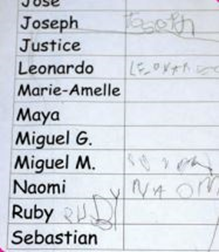5.4: Curriculum Occurs Throughout the Day
As previously stated, young children learn in everyday moments of play and interaction. A child who arrives in the classroom and sees his name written on a cubby where he deposits what he brought from home is learning. That learning is amplified when he walks to a nearby metal tray (labeled with the words “Home” and “School”) and moves the magnet attached to his photo from the “Home” side of the frame to the “School” side. The learning continues when he stops to write his version of his name in the sign-in binder, located near a ring of cards with a child’s name and photo printed on each. In this area, he can observe the accompanying family member sign him in as well.

A bit later, that same child is learning when he describes to the teacher his frustration that his “favorite tricycle is still being used by another child.” The teacher suggests what he might say to encourage the other child to explore how the two of them might cooperate. After that conversation, his learning continues as he ventures into the block area and takes on the challenge of turning a container of blocks and boxes into a gas station, negotiating varying roles in the pretend play with his friends. At lunch, when he pours milk into his glass using a small measuring cup, he is learning. Each moment of learning, in this example, emerged from thoughtful, intentional curriculum planning. Early childhood teachers plan such opportunities for young children to learn throughout the day.
Teachers’ early childhood curriculum plans include the physical space as a context for learning. This means that teachers plan what, when, and how materials and furnishings are made available to the children for use. Teachers also plan the social environment—the roles, responsibilities, and guidance offered to children—during the daily routines and during moments of spontaneous interactions. A broad definition of curriculum includes the following components:
- Play spaces designed as environments for learning
- Care routines designed to invite children’s active participation
- Interactions and conversations with children that support their understanding of themselves and others

